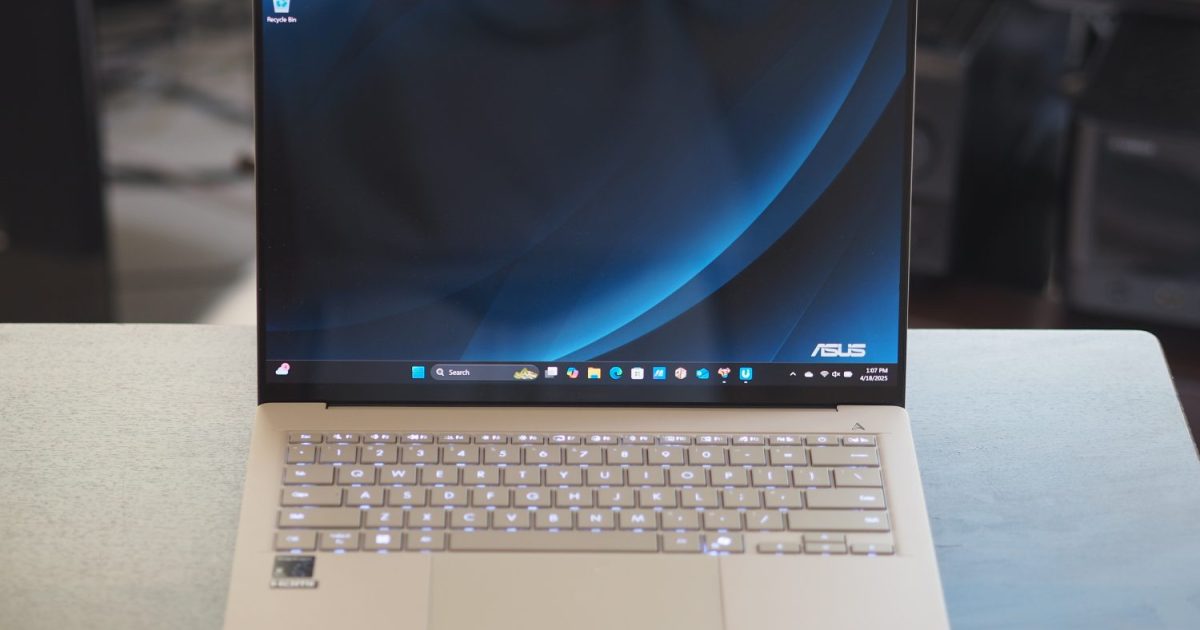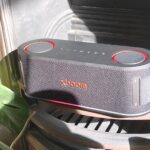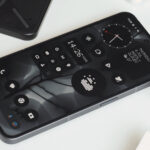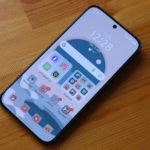Asus Zenbook A14
MSRP $1,000.00
“The Asus Zenbook 14 is remarkably light and incredibly long-lasting.”
Pros
- Thin and extremely light
- Comfortable Ceraluminum material
- Solid productivity performance
- Excellent battery life
- Great OLED display
- Attractive price
Cons
- Lid is too loose
- Only one configuration available
Sometimes, a company makes a laptop with a singular design goal in mind, such as making it as light as possible. The result can be a laptop that compromises in too many areas, such as a too-small battery or a construction that feels a little flimsy. Asus has introduced the Zenbook A14 that’s one of the lightest 14-inch laptops ever, and I was a little worried that it might suffer the same fate as some other really light machines.
Fortunately, it does not. It’s solidly built (with just one complaint) and it has a large battery that affords exceptional battery life, even with an excellent OLED display. The trick: Asus used a new material to achieve that light weight, along with the highly efficient Qualcomm Snapdragon X chipset and a lower display resolution. The result is a laptop that looks and feels great, runs fast, and lasts a long time.
Specs and configuration
| Asus Zenbook A14 | |
| Dimensions | 12.23 x 8.42 x 0.63 inches |
| Weight | 2.4 pounds |
| Display | 14.0-inch 16:10 FHD+ (1920 x 1200) OLED, 60Hz |
| CPU | Qualcomm Snapdragon X Plus X1P-42-100 |
| GPU | Qualcomm Adreno |
| Memory | 16GB 32GB |
| Storage | 512GB SSD 1TB SSD |
| Ports | 1 x USB4 1 x USB-A 3.2 Gen 2 1 x HDMI 2.1 1 x 3.5mm headphone jack |
| Camera | 1080p with infrared camera for Windows 11 Hello |
| Wi-Fi | Wi-Fi 6E and Bluetoth 5.3 |
| Battery | 70 watt-hour |
| Operating system | Windows 11 on ARM |
| Price | $1,000+ |
Although there are several configuration options listed in the Asus materials, there’s only one configuration I could find that available to buy today. It costs $1,000, and it includes a Qualcomm Snapdragon X Plus chipset, 16GB of RAM, a 512GB SSD, and a 14.0-inch FHD+ OLED display.
That’s a good price for a well-configured laptop that has twice the storage of the Apple MacBook Air 13 (M4). It qualifies as a midrange price, while the laptop feels like it’s quite premium. So, it’s not a bargain, exactly, but you won’t feel like you spent too much money.
Design

The Zenbook A14’s primary claim to fame is its incredibly light weight, coming in at just 2.4 pounds. That’s not the lightest laptop we’ve seen, but it’s light enough for a 14-inch laptop that you’ll barely notice it in your backpack — and yet, to my surprise, it avoids feeling flimsy as lightweight laptops sometimes do. That’s thanks to a new “Ceraluminum” compound in the lid, keyboard frame, and base. Ceraluminum is the result of dipping aluminum in a bath and applying high voltage, a process that transforms the surface metal into what Asus describes as a “hard, ceramic-like layer.”
And it certainly feels different. In fact, it felt weird to me when I first pulled it out of the box, but as I handled the Zenbook A14 a little more, I found myself liking it. And another plus is that the Ceralumium promises to keep the surface free of scratches and blemishes. For example, I couldn’t get it to hold onto a fingerprint no matter how hard I tried.
The keyboard deck and chassis bottom are solid, and the very thin lid has just the slightest give under pressure. That’s pretty good, considering that some other premium laptops show the same and they’re not nearly as light. That Ceraluminum texture has a warm feel, too, and while the edges are a little sharp they didn’t cut into my wrists. The Apple MacBook Air 13 is a little more solid all around, but it’s also heavier at 2.7 pounds in spite of being a bit smaller and much thinner (o.45 inches versus 0.63 inches) with a 13.6-inch display. And maybe what’s most impressive about the Zenbook A14’s light weight is that there’s still a large 70 watt-hour battery inside, which as we’ll see pays some real dividends in longevity.

I do have one complaint about the ZenBook A14’s construction: the hinge is too loose. The lid can be opened with one hand, which is great, but it also wobbles more than I like and falls backward when the laptop is lifted by the base. And, the hinge won’t support the lid when it’s any less than about halfway open, meaning it falls closed with a resounding snap. Asus did a ton of testing to verify that the laptop is robust, but even so it was a bit disconcerting. I wish the hinge was a bit firmer, and I wonder if maybe Asus needs to work on the design a bit. The reviewer’s guide has a paragraph on the “EasyLife” design, and I can’t say that my review unit’s hinge matches up very well.
Aesthetically, the Zenbook A14 stands apart from some other Zenbooks I’ve reviewed. It has none of the geometric patterns you’ll find on many Asus laptops, and the Iceland Gray and Zabriskie Beige (?) color ways look nice but are wholly minimalist. There’s a roundness to the design that I like, and its thin display bezels contribute to a modern look. I still slightly prefer some other laptops in this regard, like the MacBook Air 13 and the HP OmniBook Ultra 14, but I have no complaints about the Asus.
Keyboard and touchpad

The keyboard is spacious enough, with a comfortable layout and large keycaps. The switches are light with a snappy bottoming action, but it lacked a bit of the crispness that I like. I got up to speed quickly enough and writing this review wasn’t fatiguing, but I’d rate the keyboard just a step behind Apple’s Magic Keyboard and the excellent version HP is using on its OmniBook and EliteBook lineups.
The touchpad is reasonably large, and it’s a mechanical version with buttons that are quiet and snappy. As far as mechanical touchpads go, it’s fine, but more and more laptops are including haptic touchpads that I like a lot better. Apple’s Force Touch touchpad with its Force Click feature remains the best touchpad on a laptop today.
Connectivity and webcam
Connectivity is good, with two fast USB4 ports, a USB-A port for legacy devices, and an HDMI 2.1 port. The biggest problem is that like most laptops today, the Zenbook A14 charges via USB-C and so you only have one of those ports available when plugged in. That’s not unusual, though, so it’s not really a ding against the Asus. I do prefer Apple’s MagSafe 3 connection on its MacBooks, which keeps all the ports available for use. Wireless connectivity is also one generation behind, which surprises me a little given the Qualcomm chipset.

The webcam is a 1080p version, which has become the new minimum standard. More and more laptops are being released with higher resolution webcams, but this one is good enough for a quality image. The Snapdragon X chipset has a fast Neural Processing Unit (NPU) running at 45 tera operations per second (TOPS), which exceeds the 40 TOPS required for Microsoft’s Copilot+ PC AI initiative. That means the Zenbook A14 can run the various Copilot+ AI features on-device with better efficiency. Asus also adds several of its own utilities that can utilize the NPU, such as its noise cancellation function and its StoryCube app for managing and enhancing photos and videos.
Performance

The Zenbook A14 is the first Windows on ARM laptop I’ve reviewed in the last couple of months, and I see that the platform is doing fine. There are some incompatibilities that might trip up some users, but I haven’t run across any that would matter in my workflow. I think that for most users, Windows on ARM will be fully functional. And that’s a good thing, because the Qualcomm Snapdragon X lineup is fast enough for the most demanding productivity users, and that’s this laptop’s target market. And Qualcomm also focused on efficiency, a trademark of the ARM architecture that also shows up in Apple Silicon.
My review unit used the Snapdragon X Plus X1P-42-100 chipset, an 8-core chipset running at a max multi-core frequency of 3.2GHz that boosts to 3.4GHz single-core. That makes it the second-slowest Snapdragon X chipset and well behind the faster Snapdragon X Elite chipset with 12 cores and faster speeds. Its Adreno integrated graphics run at 1.7 TFLOPs, which is also the slowest in the lineup. It’s up against Intel’s Lunar Lake chipset that’s also aimed more at efficiency. Note that all of the results listed are in each laptop’s “performance” mode.
As we can see in our benchmarks, the Zenbook A14 was faster than Lunar Lake but not as fast as the Snapdragon X Elite. That’s to be expected. It fell even more significantly behind in the 3DMark Wild Life Extreme benchmark, where Lunar Lake’s Intel Arc 140V graphics did better.
The conclusion is that the Zenbook A14 is a very fast laptop for demanding productivity workflows, but it won’t impress in gaming or creative tasks that depend on a fast GPU.
| Cinebench R24 (single/multi) |
Geekbench 6 (single/multi) |
3DMark Wild Life Extreme |
|
| Asus Zenbook A14 (Snapdragon X Plus / Adreno) |
108 / 690 | 2436 / 11242 | 3262 |
| Acer Swift Go 14 AI (Snapdragon X Plus / Adreno) |
107 / 716 | 2413 / 11388 | 3231 |
| HP OmniBook X (Snapdragon X Elite / Adreno) |
101 / 749 | 2377 / 13490 | 6165 |
| HP OmniBook Ultra Flip 14 (Core Ultra 7 258V / Intel Arc 140V) |
116 / 598 | 2483 / 10725 | 7573 |
| Lenovo Yoga Slim 7i Aura Edition (Core Ultra 7 258V / Intel Arc 140V) |
109 / 630 | 2485 / 10569 | 5217 |
| Asus Zenbook S 14 (Core Ultra 7 258V / Intel Arc 140V) |
112 / 452 | 2738 / 10734 | 7514 |
| MacBook Air 13 (M4 10/8) |
172 / 854 | 3751 / 14801 | 7827 |
Battery life

As I mentioned earlier, the Zenbook A14 manages to be very light while packing in a large 70 watt-hour battery. That’s plenty for a 14-inch laptop, and when you consider the highly efficient Qualcomm chipset, it bodes well for longevity. Even better, Asus made just the right compromise with the display, offering a great OLED panel but keeping the resolution down a bit.
The result is some of the best battery life I’ve seen from a Windows laptop. The best machines in our comparison group use IPS displays, such as the Qualcomm-based Acer Swift Go 14, meaning that the Zenbook A14 does a great job of offering up a quality visual experience that nevertheless lasts for a long time. This is potentially multi-day battery life, depending on your workflow — something that, until recently, only the MacBook Air 13 with Apple’s incredibly efficient Apple Silicon processors could boast.
| Web browsing | Video | Cinebench R24 | |
| Asus Zenbook A14 (Snapdragon X Plus) |
15 hours, 4 minutes | 21 hours, 55 minutes | 1 hour, 32 minutes |
| Acer Swift Go 14 (Snapdragon X Plus) |
15 hours, 29 minutes | 21 hours, 38 minutes | 1 hour, 42 minutes |
| HP EliteBook X G1a (Ryzen AI 9 HX 375) |
N/A | 7 hours, 27 minutes | 1 hour, 27 minutes |
| Samsung Galaxy Book5 Pro 360 (Core Ultra 5 226V) |
12 hours, 50 minutes | 19 hours, 30 minutes | 2 hours, 18 minutes |
| HP OmniBook Ultra Flip 14 (Core Ultra 7 258V) |
11 hours, 5 minutes | 15 hours, 46 minutes | 2 hours, 14 minutes |
| Lenovo Yoga Slim 7i Aura Edition (Core Ultra 7 258V) |
14 hours, 16 minutes | 17 hours, 31 minutes | 2 hours, 15 minutes |
| Asus Zenbook S 14 (Core Ultra 7 258V) |
16 hours, 47 minutes | 18 hours, 35 minutes | 3 hours, 33 minutes |
| Microsoft Surface Laptop (Snapdragon X Elite X1E-80-100) |
14 hours, 21 minutes | 22 hours, 39 minutes | N/A |
| HP Omnibook X (Snapdragon X Elite X1E-78-100) |
13 hours, 37 minutes | 22 hours, 4 minutes | 1 hour, 52 minutes |
| Apple MacBook Air (Apple M4 10/8) |
16 hours, 30 minutes | 20 hours, 31 minutes | 3 hours, 47 minutes |
Display and audio

As I just said, Asus chose a display that compromises between quality and sharpness. It’s a 14.0-inch 16:10 FHD+ (1920 x 1200) OLED panel, meaning it’s not as sharp given the screen size as the more common 2.8K variety, but unless you pay a lot of attention you might not notice. I’m a writer who loves sharp black text on a white background, and OLED provides the contrast while 2.8K provides the sharpness. But I suspect that most people won’t notice the lower resolution nearly as much as they notice the inky blacks and dynamic colors.
According to my colorimeter, the display enjoys the usual spectacular OLED quality. It’s bright at 411 nits, well above the 300-nit standard we’ve had for years. Blacks are perfect, and so contrast is extremely high. Colors are wide at 100% sRGB, 97% AdobeRGB, and 100% DCI-P3, and they’re incredibly accurate at a DeltaE of 0.88 (1.0 or less is considered excellent for any use).
If you don’t demand the sharpest text, you’ll love this display. It’s great for every use including productivity and creative work (although the performance doesn’t quite keep up here), and media consumption including high dynamic range (HDR) content looks great.
The audio isn’t quite as impressive. The dual downward-firing speakers are loud, but there’s some distortion when turned all the way up. And the lack of bass is palpable, with the clear mids and highs coming across as a little tinny. You’ll want to use a pair of headphones for more than just the occasional YouTube video, and the MacBook Air 13’s quad speaker setup is a lot better.
A really light laptops that still lasts a long time
The Zenbook A14 kind of grew on me the more I used it. At first, it just felt kind of weird, with a surface that wasn’t quick like plastic but wasn’t quite like metal, either. But the more I handled it, the more I liked it. All the work Asus put into its Ceraluminum material wasn’t wasted. I wish the hinge was tighter, but that wasn’t at all a dealbreaker for me.
And I love that even though it’s very light, it still got class-leading battery life with solid productivity performer. It’s right up there with the MacBook Air 13 (M4) which is saying something. If you’re looking for a 14-inch laptop that you don’t need for gaming or video editing, then you really need to give the Zenbook A14 some serious consideration.
Read the full article here

















